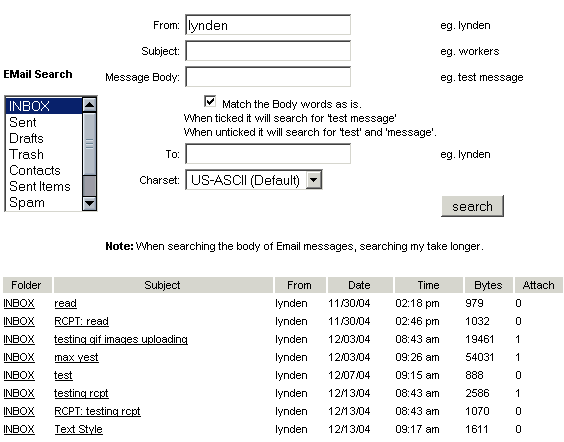 |
This will delete the message currently being viewed. |
 |
To reply to the message, select a message and then click on the Reply icon. You can
then compose and send your message. |
 |
To reply to all of the recipients of a message, click on the Reply All icon.
This replies to all the people in the To: and Cc: fields in the message currently
being viewed. |
 |
This will send the message on to a new address, using your address as the from and
reply-to address. Either type in the email address of the person or people you would
like to forward to, or choose from the 'Address Book' and/or 'Recent Addresses'. |
 |
This will send the message on to a new address and will keep the original from and
reply-to address. |
 |
To print a message, click on the Print icon. |
 |
Select the destination folder, then click "Move" to move the current message,
or 'Copy' to create a copy in the selected folder. |
 |
This will view the previous message in the list |
 |
This will view the next message in the list |
 |
This will add the address of the person who sent this message to your recent addresses list.
A confirmation message will appear when the address is successfully saved. |
 |
This will take you to the Add Addresses screen. The 'Full Name' and 'EMail' fields will be
filled out. Add a Nickname and any other details you wish to keep, then click "Add Address'
to save. |
 |
This will delete this message and automatically delete all messages you recieve
from this person in the future.
Use this feature carefully! |
|
If you would like to change your message viewing options, check one or more of the following,
then click, 'Set View".
- Raw - This forces the body of the message to be display as it is is stored on the IMAP or POP server.
- Headers - This forces the complete headers of the E-Mail to be displayed.
- Variable width font - This will display the body of the message in a variable width
font instead of a fixed width font.
- Inline images - This will display common types of image file attachments in the body of
the message.
- Enable attached scripts etc. - When viewing HTML inline, WebMail, for security reasons automatically
removes scripts, forms and applets. Checking this box will stop these from being removed. This
setting, unlike the others, will not be saved and you need to check this each time you want to
see the script, forms and applets.
- Show both 'alternative' parts - This will make WebMail display both the plain text and the HTML
parts of a multi-part message.
|
 |
To search for messages, click on the SEARCH icon, choose the folder
or folders that you would like to search in, and then set the search criteria. (To select multiple
folders, press and hold Ctrl and then select your folders using the left mouse button). |
- From - You can search by the sender's full email address, part of their email address,
and by the nickname or full name of those in your address book.
- Subject - You can search based on any text in the subject of the message.
- Message Body - You can search based on any text in the message body of the message.
- To - You can search by the recipient's full email address, part of their email address,
and by the nickname or full name of those in your address book.
If you have filled in more than one field, then WebMail will search using the AND rule. For
example; if you fill in 'csmith@domain.com' in the 'From' field and the word 'jelly' in the
Subject field, then the search function will search and display messages received from
csmith@domain.com and has the word 'jelly' as the Subject.
However, you can check the "OR" check box to use the OR rule instead of the AND rule.
Using the same example above, when you use the OR rule, instead of searching and displaying
messages that were received by csmith@domain.com and have the word 'jelly' in the
Subject, it will return any messages received from csmith@domain.com or messages that
have the word 'jelly' in the Subject.
Wildcard searching is another feature that you can use when searching for messages.
There are two methods for wildcard searching:
- Using '*' - '*' represents more than one character. For example, if you would like to
search for all messages that have originated from @domain.com, just type in *@domain.com in the
From field. This will return all of the messages that have been received from @domain.com
- Using '?' - '?' represents a single character. For example, if you would like to
search for a message with the Subject jelly but was not sure if jelly ended with a 'y' or an 'i',
just type jell?.in the 'Subject' field and it will return the message or messages that have jelly
as the Subject. However this will also include messages that have jello as the Subject.
Please note that the search function is not case sensitive, e.g. searching for jelly
will also find JELLY or Jelly

Please note that the search function cannot search through attachments, e.g. picture files or
Word documents.
|
|












